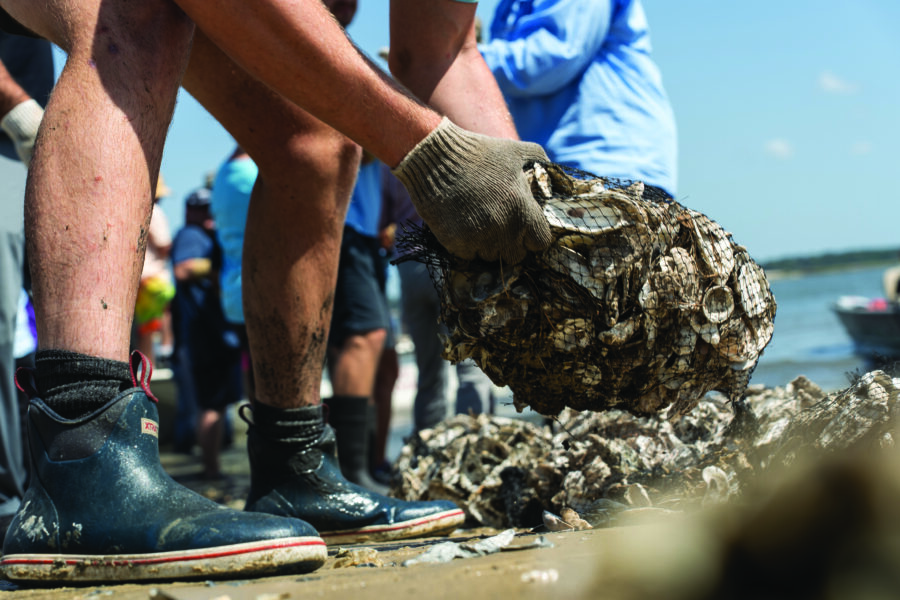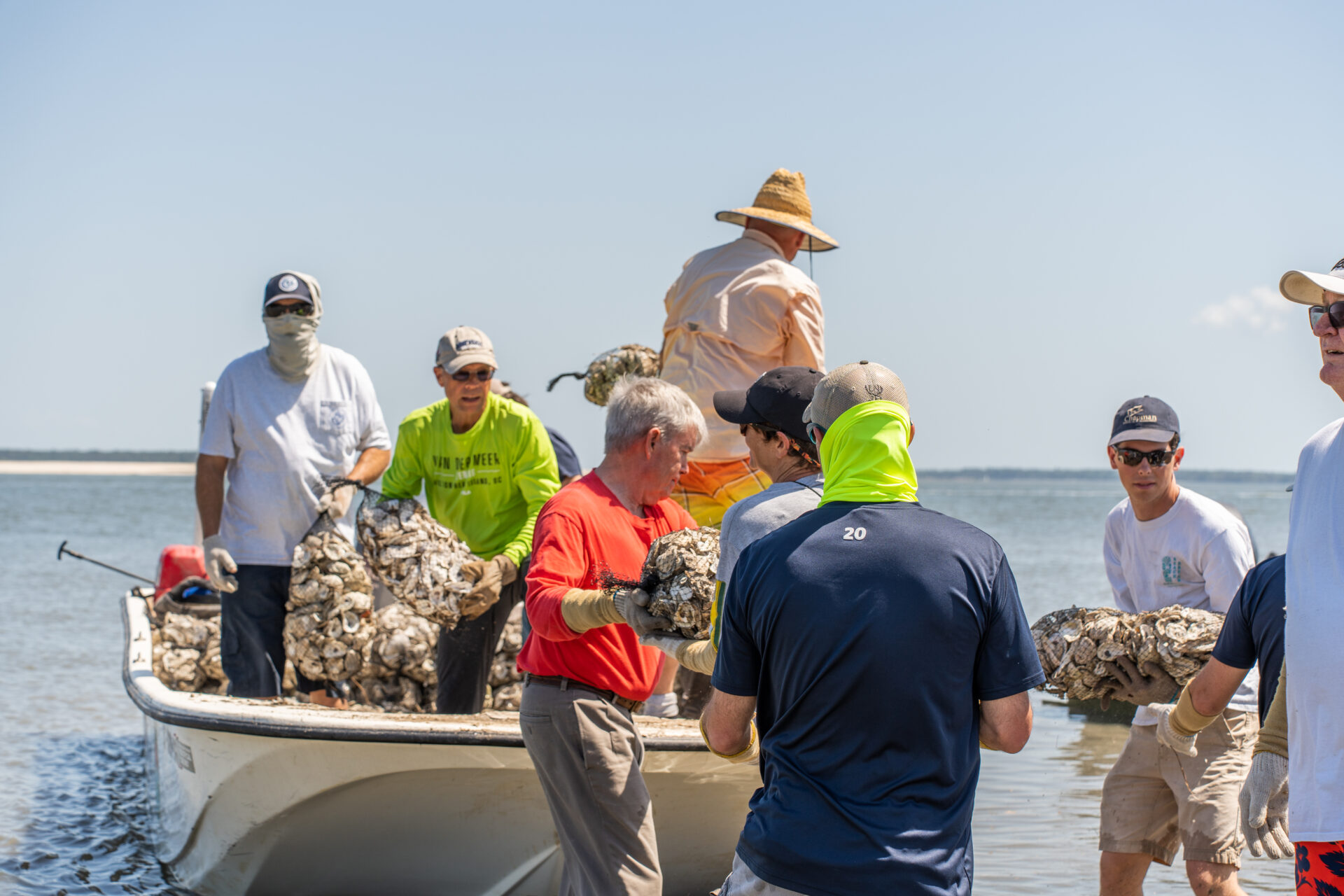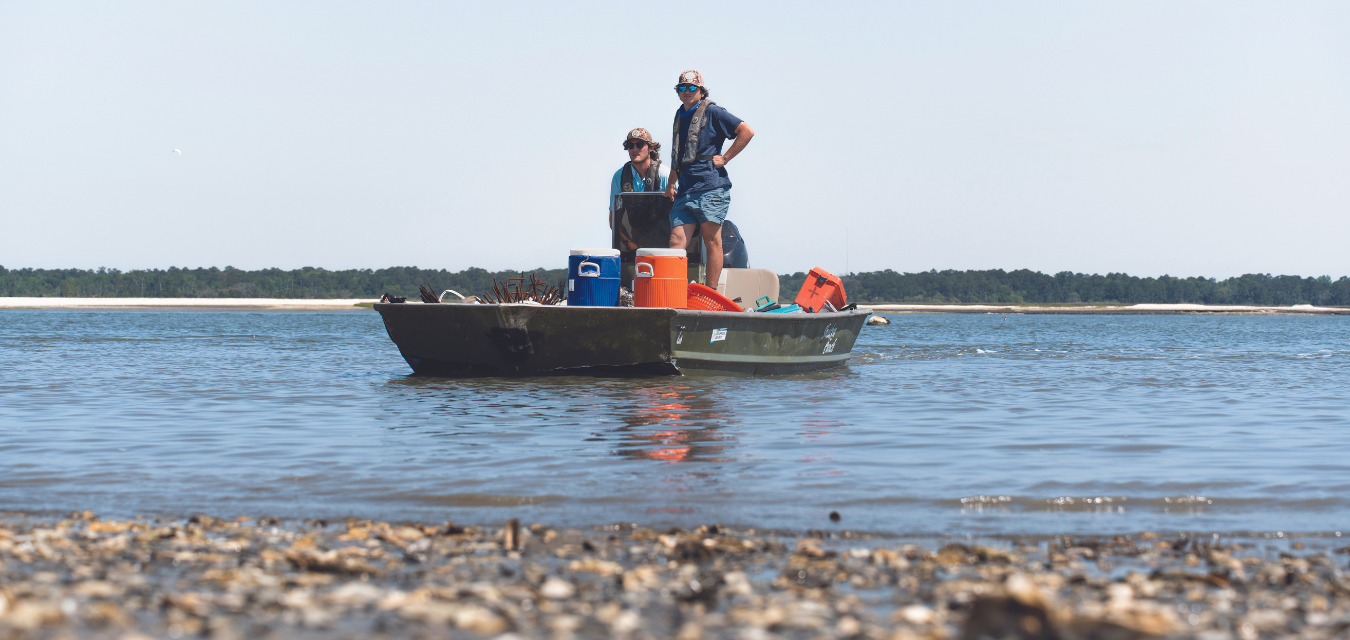For many in the South, winter’s biggest highlight is peak oyster season. The sweet, briny meat captured between two shells is at its fullest potential these next few months. But what happens once those shells are shucked? Many states across the Southeast now have an answer: oyster shell recycling. From Virginia’s Chesapeake Bay Foundation to the Galveston Bay Foundation in Texas, oyster shell recycling centers are now prevalent along coastlines, with many communities collecting millions of pounds each year in order to divert shells from landfills and place them back in the water in a constructive way. In South Carolina, which boasts half a million acres of salt marsh, the most of the Atlantic states, there are more than 30 collection sites for oyster shell recycling, thanks in part to SCORE, or the South Carolina Oyster Recycling Enhancement program.

SCORE’s Mission for Oyster Shell Recycling
Established in 2001 by the South Carolina Department of Natural Resources (SCDNR), SCORE’s goals are twofold: to utilize oyster shells to rebuild oyster reefs that will protect salt marshes and estuaries, and to foster community involvement. By engaging the community to recycle shells and also volunteer to help with placing the shells back in the water, the organization conducts as many as 40 oyster bed rebuilds each year.
“Oysters and marshes are the lifeblood of the estuaries,” says Michael Hodges, an oyster restoration biologist and program coordinator at SCDNR. “And the reason we want to get people involved is so we can introduce them to the great importance of our ecosystem; they then become spokespeople for their natural resources.”
In spring 2022, SCORE held one of its oyster reefs rebuild efforts on Daufuskie Island, where several dozen volunteers signed up for a half-day project. The first team, led by a few of SCORE’s nine full-time staff members, met at a dock in Bluffton, where several hundred pounds of oyster shell had already been placed into loose mesh bags. The shells were collected throughout the year at the state’s collection sites and then left outside to “cure” for three to six months, allowing any bacteria to die off.
Once bagged, the shells were then loaded onto a truck. That day, the volunteers were tasked with moving oyster bags from the truck to a boat for the transfer over to Daufuskie. SCORE, well-versed in the work, arranged the team into two long lines from the truck to boat, facing one another with arms outstretched. As the bags came off the truck, they were “zipped” down the line of outstretched arms, straight onto the boat. Once the bags were loaded and the boat (cheekily named Shucker Punch) made its way to Daufuskie, another group of volunteers waited at the reef build site—a short stretch of beach set beside the island’s high-traffic ferry docks—just as the tide was hitting its lowest point.
When the Shucker Punch landed, the SCORE team marked out the new oyster reef’s boundaries, and the human-powered zipper line began again, with volunteers navigating pluff mud and packing the bags together into neat rows to create a long, rectangular slab of the shell. Once secured with sections of rebar, the reef was set, ensuring that as the water warmed, baby oysters would have a place to spawn that season.

Signs posted on either end of the reef are there to remind: These oyster beds are not open for harvest. “They’re meant to stay in the water and provide a habitat,” Hodges said. Daufuskie’s project, executed in partnership with the Daufuskie Island Conservancy, took place five years after the island’s first reef rebuild in 2017.
As volunteers loaded oyster bags onto the beach, Hodges and other SCORE employees pointed out the now-five-year-old reef—it looked like any other stretch of oyster bed, with bivalves growing tall and sharp, and healthy waves of spartina marsh grass growing right up against it. “That’s exactly what we’re looking for,” Hodges said that day. “It’s habitat creation, erosion control. A living shoreline.”
As keystone species to estuaries, oysters and their reefs help support more than 130 different species of marine life that utilize estuaries as their nursing and feeding ecosystem—everything from small invertebrates up to red fish and blue crabs.
The oysters also act as filter feeders, with each bivalve filtering as much as 50 gallons of water per day. Each bag of spent oyster shells could recruit as many as 450 new oysters. With around 350 bags of shell going into each reef rebuild, that’s millions of gallons of filtration happening where it wasn’t happening before. While the environmental impacts are remarkable, what concerns many coastal residents is erosion. As tides rise higher and storms become more aggressive due to warming water temperatures, our natural coastlines are in danger of being lost to storm surges, high tides, and more.
Oyster reefs act as natural barriers, giving tides and battering waves something to fight against, rather than washing the shoreline away. SCORE puts together oyster reef rebuilds like the one on Daufuskie during the spring and summer, pulling from those oyster shell collection sites throughout the year. Besides consumer recycling, the biggest contributors to the cause are restaurants, many of which voluntarily recycle their shells—not an easy feat when it takes time for a busy kitchen and dishwashing station to scrape oyster shells into a specific receptacle (the volunteer group on Daufuskie found more than one oyster fork in the bagged shells) and then transport those shells to a collection site.
In nearby Hilton Head, the nonprofit Outside Foundation received a grant in 2017, which they used to kick off an oyster recycling and reef-building program. Today, the group entices restaurants and community oyster roasts to recycle shells by offering a pickup service. That, Hodges notes, is precisely why SCORE works. “Community involvement is crucial to the success of our program,” he says.
Nine Ways to Help Oyster Reef Restoration on the Southeast Coast
Whether you’re looking to recycle your own oyster shells or interested in volunteering to help rebuild oyster beds, these are the organizations to seek out in each coastal state.
Virginia Oyster Recovery Partnership
North Carolina Coastal Federation’s Recycle for Reefs
South Carolina Oyster Recycling Enhancement
G.E.O.R.G.I.A Oyster Restoration Project
FL.O.O.R. (Florida Oceanographic Oyster Restoration)
Alabama Oyster Shell Recycling Program
MS Gulf Coast Oyster Shell Recovery Program
Coalition to Restore Coastal Louisiana Oyster Shell Recycling Program
share
trending content
-
Staff Meal
by Tate Jacaruso -
In the Spirit: Distillery of Modern Art (DoMA) | Listen
by Amber Chase -
Asian Food Booms In the South
by TLP Editors -
Stirrups Restaurant Offers Fine Dining Like Nowhere Else
-
Our Summer 2024 Issue is Here!
by Erin Byers Murray





